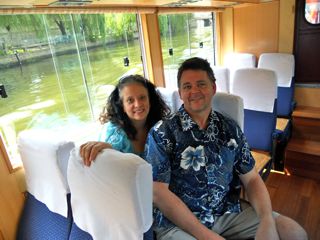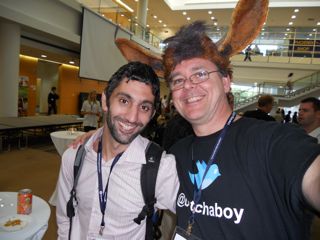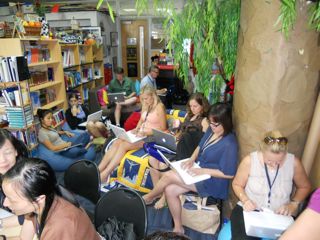 Despite the fact that I know many teachers who would rank Twitter as the most valuable and powerful networking tool they have access to, there are still many more who simply don’t “get” the value of Twitter. I’ve been to lots of conferences over the last few years where the enormous value of belonging to a Personal Learning Network was being touted, and Twitter is nearly always being suggested as the ideal tool for building that network. At one recent conference I asked for a show of hands for who was not yet on Twitter, and many hands went up… my response was “Why not? What are you waiting for? How many times do you need to hear people say that Twitter is the most valuable tool they have, before you actually try it for yourself?”
Despite the fact that I know many teachers who would rank Twitter as the most valuable and powerful networking tool they have access to, there are still many more who simply don’t “get” the value of Twitter. I’ve been to lots of conferences over the last few years where the enormous value of belonging to a Personal Learning Network was being touted, and Twitter is nearly always being suggested as the ideal tool for building that network. At one recent conference I asked for a show of hands for who was not yet on Twitter, and many hands went up… my response was “Why not? What are you waiting for? How many times do you need to hear people say that Twitter is the most valuable tool they have, before you actually try it for yourself?”
I spoke to a group of preservice teachers recently who were basically told by their lecturers that they needed to join Twitter. Despite the fact that it was being promoted to them as a powerful way to learn and network with others, most of them seemed to join up simply because it was part of their assessment requirement. Because they joined Twitter “under duress”, I don’t expect them to actually buy into it, use it well, or continue to use it past the mandated requirement to use it. And that’s a bit of a shame.
In contrast to all this is the general sentiment among many teachers that “we need more PD!”, or the always-amusing “How can they expect us to learn new things if all we get is a few PD days a year?”
If you still believe that professional development is what happens on those two or three days each year when you sit in a classroom and have some expert “deliver” it to you, I have bad news. That model is no longer sustainable and the days of PD as something that is done “to you” by “experts” a couple of times a year are over.
Learning needs to be ongoing. The world is changing. There are new tools that can help students learn, new ideas about learning, new brain research, new emerging technologies, new social structures, and so on… to think that you can maintain a professional outlook by attending two or three PD workshops a year is almost laughable. To keep up with new learning, you really need to be plugged in to an ongoing source of professional discourse and resource sharing. It needs to be something that happens regularly, at least several times a week. Like so many other aspects of the 21st Century, some of the “ways we’ve always done things” don’t really cut it anymore.
So how can something at simple as Twitter possibly be used to stay professionally current?
How I use my Twitter PLN to learn
I’ve been keeping an eye on my Twitter stream for the past 10 minutes or so. Using the Twitter app for Mac, it sits in a narrow vertical window on the right side of my screen and as the people I follow add their tweets they flow by in a steady stream that updates every few moments. How fast this flow happens is obviously dependent on how many people you follow… I follow about 2600 people, so it tends to be a pretty steady stream of tweets, but yours might be more or less. Occasionally I glance at this “stream of (networked) consciousness” and spot little gems that look interesting.
For example in the last ten minutes I’ve spotted the following things…
- A great quote about writing from Bud Hunt
- A link to a promising new open source 3D animation tool
- A good article on landing your dream job in a networked world
- An interesting question about URLs posed by Jim MacMillan
- News about Twitter’s new advanced search features
- A link to a thought provoking article about game based learning
- A great teaching idea from Penny Coutas about using Xtranormal for language learning
- An link to interesting article about the relevance of the social sciences
- A student work sample of an excellent global collaborative project
- A link to a list of the top 10 lazy email habits
- A link to an article about the effectiveness of online learning for young students
- A link from Alec Couros to a 5 minute video called “Cultural Differences“
- A fascinating article about Facebook scams
…to name but a few.
In the same 10 minutes worth of tweets, I also responded to a couple of questions from other people that I felt I could help them with, saw a funny story about Moodle, watched an amusing exchange between some people I know, and ended up getting invited into an Elluminate session about developing Moodle courseware.
Just ten minutes. Even just skimming through that list of things would give me more relevant PD than most teachers get exposed to in a whole year. And those of us who use Twitter in this way are able to tap this stream of information any time we like.
(I hope you also noticed that I still don’t know what Ashton Kutcher had for lunch, or what crazy antics Charlie Sheen is up to. I don’t care about that stuff, so I don’t follow those people, so I don’t see those tweets. Twitter works because you get to make choices about who is part of your network. You create relevance for yourself.)
Now, before you assume that I spend my whole day getting sidetracked by Twitter, let me assure you that’s not the case. I’m telling you about this 10 minute slice of time to make the point that Twitter, when you build a network of relevant people, is an amazingly rich sources of ideas, inspiration and connections.
I don’t read every tweet. I don’t follow every link. I let most of the tweetstream just flow by me, only dipping into it if I get a moment. If I spot something interesting I hit the star to favorite it and come back to it later. If anything really good turns up in the stream and I miss it, it gets retweeted over and over so the chance of me seeing it is still pretty good. But mostly it’s just there, flowing by, ready for me to dip into it and pull out a few gems whenever i have a moment. Do that every day and pretty soon you have a substantial body of PD building up.
I understand why people find it hard to get their head around Twitter. I understand why people are still skeptical when they hear others say things like “Twitter is the best PD you can get!” It sounds like complete hyperbole… How on earth can a random collection of short messages from strangers possibly compete with professionally organised training and PD sessions?
It competes because it’s more relevant, more timely, ongoing, interactive, daily and personal. Traditional PD just can’t offer all that.
If you’re one of those people who resist Twitter because it just doesn’t seem logical, please just suspend your doubt and give it a go. Don’t just join and do nothing; give it a proper go. Follow a bunch of relevant people – at least 50 or 60 – get a decent Twitter client, and open yourself to the possibilities of what a network offers. You won’t regret it.


 I was lucky enough to be teamed up with Melinda Alford, a teacher at Concordia (the host school) on the topic of Creating a Culture of Learning and Creativity. Originally from Atlanta, Georgia, but having now worked in Shanghai for the past six years, I’d not met Melinda before… in fact she was one of those teachers that wasn’t even on my PLN radar. But after working with her for a few days I have to say she is one of the most talented natural teachers I’ve ever met and it was a real joy to be able to work with her. It’s so nice when you get to work with someone who is really on the same wavelength. who shares so many of the same ideals about learning and education and is so easy to work with.
I was lucky enough to be teamed up with Melinda Alford, a teacher at Concordia (the host school) on the topic of Creating a Culture of Learning and Creativity. Originally from Atlanta, Georgia, but having now worked in Shanghai for the past six years, I’d not met Melinda before… in fact she was one of those teachers that wasn’t even on my PLN radar. But after working with her for a few days I have to say she is one of the most talented natural teachers I’ve ever met and it was a real joy to be able to work with her. It’s so nice when you get to work with someone who is really on the same wavelength. who shares so many of the same ideals about learning and education and is so easy to work with. We spent part of that first planning day tossing ideas around and creating some visual prompts. One of my big beliefs about the notion of creativity is that it should come from both sides of your brain. We were both very keen to encourage the idea that creativity is not something that just applies to “the arts”, not something that you only find in strange “arty” types who dress in strange clothes, not something that is applied to problems occasionally in a superficial way… we wanted to get the idea across that creativity is a critical thinking skill that applies to all disciplines, in all sorts of ways, all of the time. Melinda and I both had backgrounds in the creative arts as well as science and engineering, so we found it easy to weave this into our planning. To make the point, at the social event held the evening before the conference officially started, we got up on stage to promote our cohort sessions, me dressed in Elmo pyjama pants and a set of large donkey ears, and Melinda in a giant chicken outfit. At least we got noticed!
We spent part of that first planning day tossing ideas around and creating some visual prompts. One of my big beliefs about the notion of creativity is that it should come from both sides of your brain. We were both very keen to encourage the idea that creativity is not something that just applies to “the arts”, not something that you only find in strange “arty” types who dress in strange clothes, not something that is applied to problems occasionally in a superficial way… we wanted to get the idea across that creativity is a critical thinking skill that applies to all disciplines, in all sorts of ways, all of the time. Melinda and I both had backgrounds in the creative arts as well as science and engineering, so we found it easy to weave this into our planning. To make the point, at the social event held the evening before the conference officially started, we got up on stage to promote our cohort sessions, me dressed in Elmo pyjama pants and a set of large donkey ears, and Melinda in a giant chicken outfit. At least we got noticed! The other component of the conference was the unconference. Again, the problem with traditional conferences is that you sometimes don’t learn what you’d really like to learn, and it treats the “presenters” and the “audience” as two groups. If you believe that learners and teachers can have a much flatter relationship that that, the unconference model makes a lot of sense. At the first social event of the conference, participants were encouraged to write on a large sheet of paper a topic that they’d like to learn about. Equally, they were also encouraged to write down a topic they’d like to share about. These pieces of paper were then sticky-tacked to the wall and people could add a vote to the ones they were interested in the most. The ones that had enough votes then ran in the next unconference session time.
The other component of the conference was the unconference. Again, the problem with traditional conferences is that you sometimes don’t learn what you’d really like to learn, and it treats the “presenters” and the “audience” as two groups. If you believe that learners and teachers can have a much flatter relationship that that, the unconference model makes a lot of sense. At the first social event of the conference, participants were encouraged to write on a large sheet of paper a topic that they’d like to learn about. Equally, they were also encouraged to write down a topic they’d like to share about. These pieces of paper were then sticky-tacked to the wall and people could add a vote to the ones they were interested in the most. The ones that had enough votes then ran in the next unconference session time. This is really the spirit of an unconference. It’s about flexibly and dynamically connecting learners together to learn about the things that interest them. You can’t plan that sort of thing in advance because you have no advance idea of what those interests will be. An unconference only works if you place your trust in the wisdom of the crowds, if you believe that none of us is as good as “all of us”. If you believe that someone in the crowd will have the expertise to share with others, and the humility to accept that that expertise can come from anywhere, then learners become teachers and teachers become learners and our learning environment becomes flatter and less hierarchical. It goes from being about teacher and student, moving away from being about “us and them” to just being about “us”. And this is so much more reflective of the way true learning actually works.
This is really the spirit of an unconference. It’s about flexibly and dynamically connecting learners together to learn about the things that interest them. You can’t plan that sort of thing in advance because you have no advance idea of what those interests will be. An unconference only works if you place your trust in the wisdom of the crowds, if you believe that none of us is as good as “all of us”. If you believe that someone in the crowd will have the expertise to share with others, and the humility to accept that that expertise can come from anywhere, then learners become teachers and teachers become learners and our learning environment becomes flatter and less hierarchical. It goes from being about teacher and student, moving away from being about “us and them” to just being about “us”. And this is so much more reflective of the way true learning actually works.